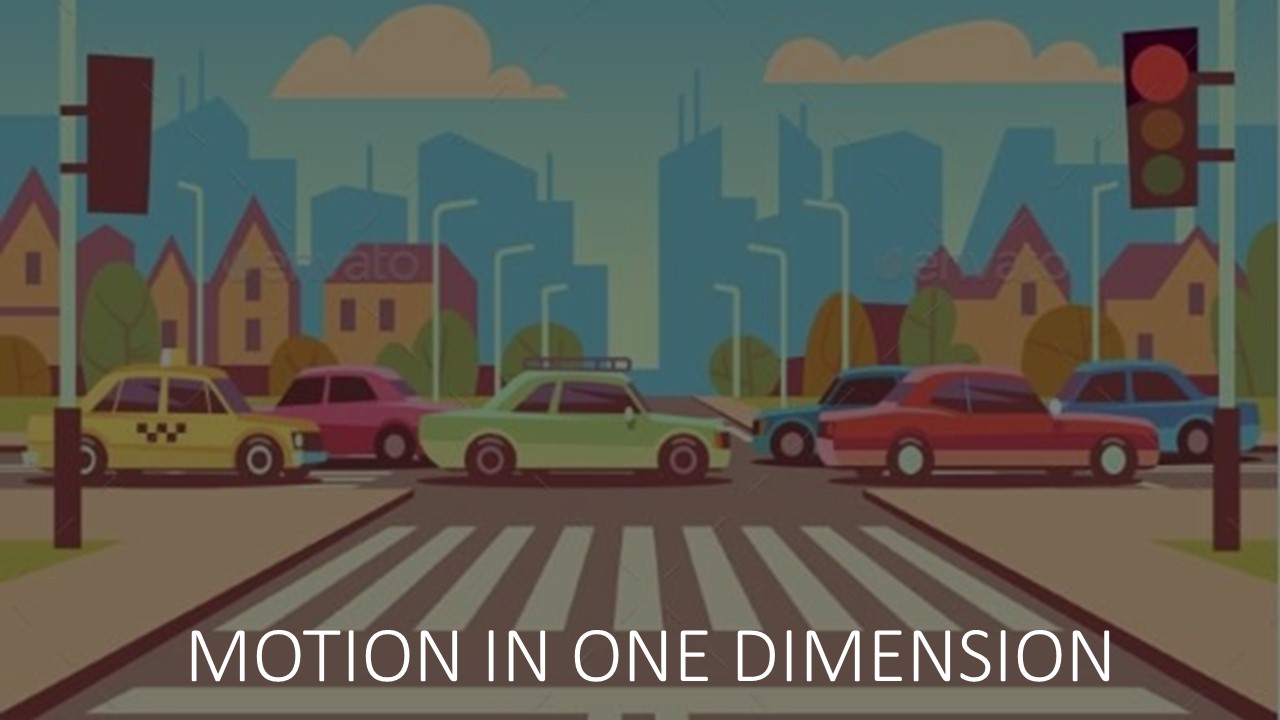Description
MOTION IN ONE DIMENSION
Terms related to motion
If you are used to the sport of skating or roller blading, you can see the skater glide along the road often starting at one point and coming to a stop with a twist or a jump at another.
There is a change in the position of the skater from point a to point b. This change of position is defined as displacement. The change in position is measured as the distance from point a to point b travelled and the displacement depends on the velocity that is defined by the skater.
In this lesson, you will learn about displacement, distance, velocity and acceleration and how they are related to each other.
One Dimensional Motion | Representation of One Dimensional Motion | Distance and Displacement | Speed and Velocity
LINEAR MOTION
Graphical representation of linear motion
The graphs of linear motion are used to show displacement at a particular time at a particular velocity. For example, on a displacement-time graph, straight lines indicate constant velocity and curved lines indicate acceleration.
In this lesson, you will learn about displacement-time graphs and acceleration-time graphs.
Displacement Time Graphical Representation
Case 1
Displacement time graph of a stationary object is a straight line parallel to the time axis
Case 2
Displacement time graph of a body moving with uniform velocity is a straight line inclined to the time axis
The velocity can be obtained by finding the slope of the straight line
S ∝ t
Case 3
Displacement time graph of a body moving with variable velocity is a curve
The velocity at any instant can be obtained by finding the slope of the tangent drawn to the curve for that instant of time
EQUATION OF MOTION
Equations of motion
In mathematical physics, equations of motion are equations that describe the behaviour of a physical system in terms of its motion as a function of time. In circumstances of constant acceleration, these simpler equations of motion are usually referred to as the “SUVAT” equations, arising from the definitions of kinematic quantities: displacement (s), initial velocity (u), final velocity (v), acceleration (a), and time (t).
First equation of motion – v- u = at.
Second equation of motion – S= ut + 1/2 at2
Third equation of motion – 2as = V2–u2
Free
Free
Free access this course
-
LevelIntermediate
-
Last UpdatedApril 1, 2022
-
CertificateYes
Hi, Welcome back!
Material Includes
-
Live Interactive classes with in-class doubt solving
-
Weekly Test and Quiz with instant tracking for progress
-
Revision of the course after testing
-
Fortnightly Parents and Tutor interactions
-
Expert monitoring of student's learning progress
-
Daily communication over call, whatsapp and mail
-
3 hours on-demand video
-
4 downloadable resources
-
Access for entire Academic Year
-
Access on mobile and Desktop
-
Assignments and review of the same
-
Tests and Correction by Board paper checkers
-
Certificate of completion and Live tracking with Grade book
Course Duration:
0
Course level:Intermediate
Enrolled:0
About Course
In this section will learn the following chapters;
1.MOTION IN ONE DIMENSION
2.LINEAR MOTION
3.EQUATION OF MOTION
Course Curriculum
MOTION IN ONE DIMENSION
ALL BOARD QUESTIONS FROM MOTION IN ONE DIMENSION CHAPTER FROM THE LAST 10 YEARS
-
08:00
-
QUIZ – SCALAR AND VECTOR QUANTITIES
-
06:00
-
06:00
-
05:00
-
06:00
-
06:48
-
06:00
-
QUIZ – EXERCISE B – SPEED AND VELOCITY, DISTANCE AND DISPLACEMENT
-
13:16
-
07:51
-
00:39
-
06:00
-
QUIZ – MOTION IN ONE DIMENSION > SPEED AND VELOCITY
-
QUIZ – MOTION IN ONE DIMENSION > REST AND MOTION
-
QUIZ – MOTION IN ONE DIMENSION > REST AND MOTION
-
QUIZ – MOTION IN ONE DIMENSION > SPEED AND VELOCITY
-
QUIZ – MOTION AND TYPES OF MOTION
-
QUIZ – MOTION IN ONE DIMENSION – SPEED AND VELOCITY II
-
QUIZ – MOTION IN ONE DIMENSION > REST AND MOTION
-
QUIZ – ASSIGNMENT – SPEED AND VELOCITY PRACTICE ASSIGNMENT
-
QUIZ – EXERCISE B – SPEED AND VELOCITY , DISTANCE AND DISPLACEMENT
-
QUIZ – EXERCISE C – ACCELERATION AND RETARDATION AND ACCELERATION DUE TO GRAVITY
EQUATIONS OF MOTION
Equation for uniformly accelerated motion
-
11:51
-
02:33
-
00:39
-
05:00
-
QUIZ – MOTION IN ONE DIMENSION > EQUATIONS OF MOTION
-
QUIZ – EQUATION OF MOTION – FORCE AND MOTION
-
QUIZ – EQUATIONS OF MOTION – THE 3 EQUATIONS OF MOTION
-
QUIZ – EQUATION OF MOTION – NUMERICALS
Student Ratings & Reviews

No Review Yet


